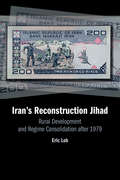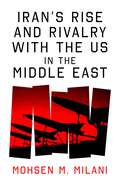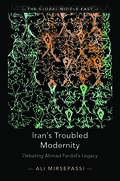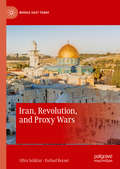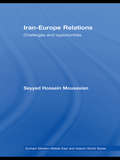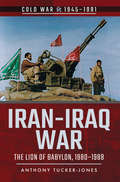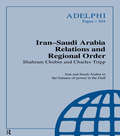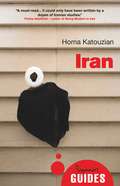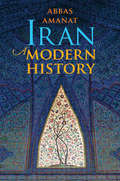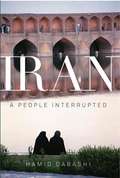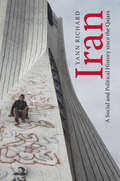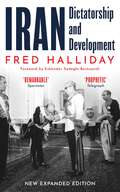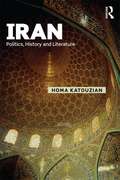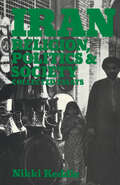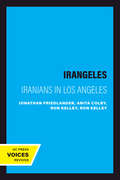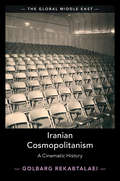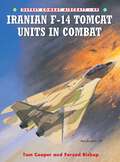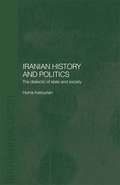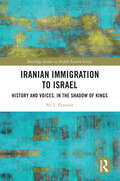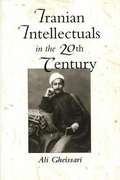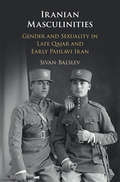- Table View
- List View
Iran's Reconstruction Jihad: Rural Development and Regime Consolidation after 1979
by Eric S. LobBased on over one hundred and thirty interviews with government officials, revolutionary activists, war veterans, and development experts, this is the first full length study in English to examine the significant yet understudied organization and ministry, Reconstruction Jihad, as a basis for understanding the political and social changes and continuities that have transpired in the Islamic Republic of Iran (IRI) over the last four decades. Exploring the success of the Iranian revolution, the state's development policies, its overall resilience and the conflicting dynamics of its attempts to mobilize and institutionalize activists, Iran's Reconstruction Jihad is one of the few studies that adopts an institutionalist approach toward analyzing critical aspects of the IRI's history and politics, with comparative implications for analyzing revolutionary processes and outcomes across other geographic regions and time periods.
Iran's Rise and Rivalry with the US in the Middle East
by Mohsen M. MilaniThe 1979 Islamic Revolution triggered a cold war between Iran and the United States – former fast friends. Despite the US&’s relentless efforts at containment, Iran has risen as a formidable power in Iraq, Syria, Lebanon, Yemen, and Gaza. Its newfound status not only frustrates the US but has swiftly become a thorn in the side of Israel and Saudi Arabia. How did Iran rise so rapidly? And as it faces ever increasing pressure at home and abroad, can it hold onto its power? Mohsen Milani guides us through the twists and turns of the Iran–US rivalry in the battlefields of the Middle East. Going from the fall of the Shah to revolutionary Iran&’s alliances with Syria, Hamas, Hezbollah, Iraqi militias, and the Houthis in the Axis of Resistance, Milani lifts the veil on Iran&’s foreign policy strategy and its implications for the region, the US and Iran itself.
Iran's Troubled Modernity: Debating Ahmad Fardid's Legacy (The Global Middle East #5)
by Ali MirsepassiAhmad Fardid (1910–94), the 'anti-Western' philosopher known to many as the Iranian Heidegger, became the self-proclaimed philosophical spokesperson for the Islamic Republic, famously coining the term 'Westoxification'. Using new materials about Fardid's intellectual biography and interviews with thirteen individuals, Ali Mirsepassi pieces together the striking story of Fardid's life and intellectual legacy. Each interview in turn sheds light on Iran's twentieth-century intellectual and political self-construction and highlights Fardid's important role and influence in the creation of Iranian modernity. The Fardid phenomenon was unique to the Iranian story, and yet contributed to a broader twentieth-century Heideggerian tradition that marked the political destiny of other countries under a similar ideological sway. Through these accounts, Mirsepassi cuts to the nerve of how deadly political 'authenticity movements' take hold of modern societies and spread their ideology. Combining a sociological framework with the realities of lived experience, he examines Iran's recent and astonishing upheavals, experiments, and mass mobilizations.
Iran, Revolution, and Proxy Wars (Middle East Today)
by Ofira Seliktar Farhad RezaeiThis book analyzes the historical quest of the Islamic Republic of Iran to export its revolution to the Muslim countries in the Middle East and beyond. The authors argue that Iran exported its revolution by using proxies such as Hezbollah, the Iraqi Shite militias, and the Houthis. The study unravels the casual chain behind less-known cases of Iranian sponsorship of al Qaeda (Central) and al Qaida in Iraq. It combines rigorous theory with detailed empirical analysis which can add to the current debate about ways to roll back Iran’s revolutionary export.
Iran-Europe Relations: Challenges and Opportunities (Durham Modern Middle East and Islamic World Series #6)
by Seyyed Hossein MousavianThis book provides an assessment of relations between Iran and Europe, identifying the areas of common interest as well as the issues of conflict, whilst putting contemporary relations into their proper context with an account of their development since the early years of the twentieth century. Written by a former diplomat who served as the first Iranian ambassador to post-reunification Germany, this book shows that despite the recent deterioration of relations between Iran and the West, Iran has enjoyed a long history of cultural, economic and political ties with many European nations such as Germany. The book explores important historical episodes, including Iran’s support of Germany in the years before the First World War; the burgeoning economic, commercial and scientific co-operation in the interwar years such that by the start of the Second World War Germany was Iran’s leading trade partner; the impact of the Islamic Revolution in 1979; and the attempts by the administration of President Rafsanjani to strengthen ties with Europe in the aftermath of the Iran-Iraq War. Iran-Europe Relations goes on to examine in detail the recent issues of conflict between Iran and Europe: disputes over weapons of mass destruction; allegations of Iranian support for terrorist groups in Afghanistan, Bosnia, Iraq and Lebanon; disagreements over human rights; the Arab-Israeli conflict and the Middle East peace process. It concludes by suggesting ways in which Iran-Europe relations can be encouraged to develop positively, overcome current obstacles and nourish the opportunities and common interests that lie beneath the surface.
Iran-Iraq War: The Lion of Babylon, 1980–1988 (Cold War 1945-1991 Ser.)
by Anthony Tucker-JonesThe bloody eight-year Iran-Iraq war is now almost forgotten, overshadowed by the subsequent Gulf War and Iraq War. However, it is best remembered for the unique so-called ‘Tanker War’ which threatened to strangle the world’s oil supplies. At the time Tucker-Jones as a defence analyst wrote extensively on the war and now brings his expertise to bear with this account of a conflict fuelled by festering regional rivalries, the Cold War and the emerging threat posed by militant Shia Islam. Fought on land, at sea and in the air using some of the most modern weapons money could buy, Western-backed Saddam Hussein’s Sunni Iraq and Shia Iran under the ayatollahs fought themselves to a standstill. Once Saddam’s armoured blitzkrieg had been halted and Iran’s human-wave counterattacks fought off, it became a war of attrition with major battles fought for the possession of Khorramshahr and Basra. Both sides resorted to chemical weapons and bombarding each other with missiles. When the war spilled over into the waters of the Gulf it sparked open Western intervention. Escalating attacks on oil tankers finally culminated in a ceasefire.
Iran-Saudi Arabia Relations and Regional Order (Adelphi series)
by Charles Tripp Shahram ChubinBoth countries will have strong incentives to test the artificial balance established by the US and from which they are excluded. Each state, in the face of continued embargoes, may find the lure of weapons of mass destruction correspondingly increased.
Iran: A Beginner's Guide (Beginner's Guides)
by Homa KatouzianAs the Western-Iranian impasse continues to dominate international affairs, politicians and the media confidently proclaim Iran the greatest threat to the Western World. But this villainous mask obscures a far more complex identity formed by a vibrant and tumultuous history.Revealing the true face of this troubled country, acclaimed expert Homa Katouzian delves deep into Iran's past, exploring how an ancient civilization at a cross-road of diverse dynasties and religions grew to become an ethnically, linguistically and culturally rich nation still bound by the Persian tradition. Major political events and key figures are brought to life as centuries of authoritarian and arbitrary rule, chaos and revolution are unraveled and analyzed, shedding new light on modern Iran and making this an indispensable resource for understanding the current situation in the Middle East.
Iran: A Modern History
by Abbas AmanatA masterfully researched and compelling history of Iran from 1501 to 2009 This history of modern Iran is not a survey in the conventional sense but an ambitious exploration of the story of a nation. It offers a revealing look at how events, people, and institutions are shaped by currents that sometimes reach back hundreds of years. The book covers the complex history of the diverse societies and economies of Iran against the background of dynastic changes, revolutions, civil wars, foreign occupation, and the rise of the Islamic Republic. Abbas Amanat combines chronological and thematic approaches, exploring events with lasting implications for modern Iran and the world. Drawing on diverse historical scholarship and emphasizing the twentieth century, he addresses debates about Iran’s culture and politics. Political history is the driving narrative force, given impetus by Amanat's decades of research and study. He layers the book with discussions of literature, music, and the arts; ideology and religion; economy and society; and cultural identity and heritage.
Iran: A People Interrupted
by Hamid DabashiHamid Dabashi traces the full sweep of Iran's history over the past two centuries and gives an analysis of key events, cultural trends, and political developments up to the collapse of the reform movement and the emergence of the new and combative presidency of Mahmoud Ahmadinejad.
Iran: A Social and Political History since the Qajars (Iran Studies #4)
by Yann RichardFrom encounters with Western powers in the nineteenth century through to a Constitutional Revolution at the beginning of the twentieth century, and from the overthrow of the democratically elected Prime Minister Mosaddeq in the 1950s to the current Islamic Republic, Iran's history has rarely been far from tumultuous and dramatic. And the ways in which Iranian society has participated in and reacted to these events have been equally fascinating and revolutionary. Here for the first time in English, Yann Richard offers his take on the social and political history of Iran since 1800. Richard's account traces the common threads of national ideology and violent conflict that have characterised a number of episodes in Iranian history. By also concerning himself with the reactions and feelings of Iranian society, and by referring frequently to Persian sources and commentaries, Richard gives us a unique insight into the challenges encountered by Iranians in modern times.
Iran: Dictatorship and Development
by Fred HallidayOriginally completed mere months before the Iranian Revolution of 1979, Fred Halliday&’s study of twentieth-century Iran was not only incredibly timely but a deeply researched, thought-provoking work. It masterfully surveys the country&’s uneven capitalist development, state-building and class structure, security and military apparatus, dissent and opposition movements, and foreign relations. Even decades later it remains among the most sophisticated and compelling analyses of this period of Iranian history. Halliday persuasively argues against crude interpretations of the Pahlavi regime as an enlightened and modernising monarchy or merely a dependent client state. Instead, he contends that to make sense of the Pahlavi regime and its vulnerabilities, it is crucial to understand the dialectic of dictatorship, development and the imperial geopolitics of the global Cold War. This new edition also includes six of Halliday&’s essays on the Islamic Republic, demonstrating how his thinking on Iran and the revolution evolved over time.
Iran: Politics, History and Literature (Iranian Studies)
by Homa KatouzianThis book offers a view of Iran through politics, history and literature, showing how the three angles combine. Iran, being a revolutionary society, experienced two great revolutions within the short span of just seventy years, from the 1900s to the 1970s. Both were massive revolts of the society against the state; the main objective of the first being to establish lawful government to make modernisation possible, and the second, to overthrow the absolute and arbitrary state, though this time mainly under the banner of religion and Marxism-Leninism and anti-Westernism. Neither of them succeeded in their lofty ideals for reasons that are explained and analysed within. The author also offers a detailed description of Iran’s short-term society, examining the political and intellectual lives of two of the most remarkable intellectuals-cum-politicians of the twentieth century. This book provides an overview of modern Persian literature, both poetry and prose, and discusses the works of three of the most remarkable Persian poets and writers of the period. It considers classical Persian literature through the great variety of its form and substance, and neo-classical literary developments in the nineteenth century, covering the whole history of Persian literature. This is crowned in the last chapter by the love poetry of one of the greatest Persian poets. Iran will be of interest to students and scholars of Iranian studies and Middle East Politics.
Iran: Religion, Politics and Society: Collected Essays
by Nikki R. KeddieFirst Published in 1983. Routledge is an imprint of Taylor & Francis, an informa company.
Irandam Ulagappor
by Pa. RaghavanA summary of events that led to the Second World War, the war that shook the entire world and the devastations it caused to the mankind, the role of Hitler in sustaining the war is well written and presents a fair protrayal in this book.
Irangeles: Iranians in Los Angeles
by Jonathan Friedlander Ron Kelley Anita ColbyThis title is part of UC Press's Voices Revived program, which commemorates University of California Press’s mission to seek out and cultivate the brightest minds and give them voice, reach, and impact. Drawing on a backlist dating to 1893, Voices Revived makes high-quality, peer-reviewed scholarship accessible once again using print-on-demand technology. This title was originally published in 1993.This title is part of UC Press's Voices Revived program, which commemorates University of California Press’s mission to seek out and cultivate the brightest minds and give them voice, reach, and impact. Drawing on a backlist dating to 1893, Voices Revived</DIV
Iranian Cosmopolitanism: A Cinematic History (The Global Middle East #3)
by Golbarg RekabtalaeiFrom popular and 'New Wave' pre-revolutionary films of Fereydoon Goleh and Abbas Kiarostami to post-revolutionary films of Mohsen Makhmalbaf, the Iranian cinema has produced a range of films and directors that have garnered international fame and earned a global following. Golbarg Rekabtalaei takes a unique look at Iranian cosmopolitanism and how it transformed in the Iranian imagination through the cinematic lens. By examining the development of Iranian cinema from the early twentieth century to the revolution, Rekabtalaei locates discussions of modernity in Iranian cinema as rooted within local experiences, rather than being primarily concerned with Western ideals or industrialisation. Her research further illustrates how the ethnic, linguistic, and religious diversity of Iran's citizenry shaped a heterogeneous culture and a cosmopolitan cinema that was part and parcel of Iran's experience of modernity. In turn, this cosmopolitanism fed into an assertion of sovereignty and national identity in a modernising Iran in the decades leading up to the revolution.
Iranian Elites and Turkish Rulers: A History of Isfahan in the Saljuq Period (Routledge Studies in the History of Iran and Turkey)
by David Durand-GuedyThe Saljuq period of the eleventh and twelfth centuries saw the arrival in Iran of Türkmen nomads from Central Asia and the beginning of Turkish rule. Through the example of the city of Isfahan, the book analyses the internal evolution of Iranian society in this period and the interaction of the Iranian elites and Turkish rulers. Drawing on an analysis of a wide range of sources, including poetic and epistolary material, this study fills an historiographical gap and casts new light on the two centuries prior to the Mongol invasion. This comprehensive analytical study provides a new contribution to the understanding of many crucial issues: the cultural divide between Western and Eastern Iran; the military potential of city-dwellers; the attitude of the Turkish rulers toward cities and city life; the action of the famous vizier Nizam al-Mulk; the meaning of the Ismaili uprising; and above all the structure of the local elite, organized into rival networks and largely autonomous vis-à-vis state powers. The study is enhanced by a variety of additional features, including extensive genealogical tables, Arabic script and maps. Providing a new understanding of the cultural identity of Iran, this book is an important contribution to the study of the history of Iran and the Medieval period.
Iranian F-14 Tomcat Units in Combat
by Chris Davey Tom CooperSo formidable an opponent did the Iraqi airforce consider the F-14 that during the Iran-Iraq War (1980-1988), they ordered their pilots not to engage F-14s and the presence of one in an area was usually enough to empty it of Iraqi aircraft. Officially losses where tiny; only one F-14 was lost in aerial combat (to a MiG-21), one to a control problem and one downed by a ground-to-air missile. This book looks at the F-14's Iranian combat history and includes first hand accounts from the pilots themselves. It will consider key engagements and the central figures involved, illustrating the realities, successes and failures of the Iranian air campaign.
Iranian F-4 Phantom II Units in Combat
by Jim Laurier Farzad BishopDifferent versions of the jet have provided the backbone of the frontline strength of the Iranian air force since the 1970s, and whole generations of Iranian pilots and ground personnel have been trained to fly and maintain them. Indeed, the type bore the brunt of active combat operations during the long war with Iraq. Iranian F-4 Phantom IIs were also some of best equipped examples ever exported by the USA. Some Iranian Phantom II pilots gathered immense experience on the type, flying it in combat for more than ten years. This book removes the veil of secrecy surrounding Iranian Phantom II operations since the Iran-Iraq War (1980-1988).
Iranian Foreign Policy During Ahmadinejad
by Maaike WarnaarWritten for scholars and practitioners puzzled by Iran's foreign policy choices, this book argues that Iran's foreign policy behavior is best understood in the context of the regime's foreign policy ideology, which is rooted in a conception of Iran as a nation changed by the 1979 Revolution and an example to other nations in a changing world.
Iranian History and Politics: The Dialectic of State and Society (Routledge/BIPS Persian Studies Series)
by Homa KatouzianThis book contains the most detailed and comprehensive statement of Homa Katouzian's theory of arbitrary state and society in Iran, and its applications to Iranian history and politics, both modern and traditional. Every chapter is a study of its own specific topics while being firmly a part of the whole argument. The discussions include close comparisons with the history of Europe to demonstrate the diversities of the logic and sociology of Iranian history from their European counterparts. Being the first modern theory of Iranian history, it is highly regarded by Iranian historians and social scientists, especially as it has helped to resolve many of the anomalies resulting from the application of traditional theories.
Iranian Immigration to Israel: History and Voices, in the Shadow of Kings (Routledge Studies in Middle Eastern Society)
by Ali L. EzzatyarExploring the fascinating history behind Iranian-Jewish immigration to Israel, this book offers a rare and untold history of one of Israel’s Middle Eastern Jewish populations. Over the twentieth century, thousands among Iran’s Jewish community left their ancestral homes and immigrated to the Jewish State, while thousands remained in Iran, even after the birth of the Islamic Republic of Iran. Using first-hand narratives, the evolution of Zionist activities and recruitment in Iran over the last century is covered, alongside an Iranian-Jewish population that, unlike other Middle Eastern Jewish communities, did not ultimately arrive in the Holy Land as a majority of their community. For those that did arrive (or, make aliyah) the Israeli nation-building process had unique ramifications. The integrative process and current status of the Iranian community in Israel is also examined, providing an intimate picture of Iranian life in Israel, nearly 75 years after Israel’s establishment. A natural addition to any collection on Jewish or Israeli history, and essential reading for a full understanding of Iran-Israel relations, students of Israeli nation-building and affairs, as well as Iranian history, demographics, and politics will find this book invaluable.
Iranian Intellectuals in the 20th Century
by Ali GheissariSince the middle of the nineteenth century, Iranian intellectuals have been preoccupied by issues of political and social reform, Iran's relation with the modern West, and autocracy, or arbitrary rule. Drawing from a close reading of a broad array of primary sources, this book offers a thematic account of the Iranian intelligentsia from the Constitutional movement of 1905 to the post-1979 revolution. Ali Gheissari shows how in Iran, as in many other countries, intellectuals have been the prime mediators between the forces of tradition and modernity and have contributed significantly to the formation of the modern Iranian self image. His analysis of intellectuals' response to a number of fundamental questions, such as nationalism, identity, and the relation between Islam and modern politics, sheds new light on the factors that led to the Iranian Revolution--the twentieth century's first major departure from Western political ideals--and helps explain the complexities surrounding the reception of Western ideologies in the Middle East.
Iranian Masculinities: Gender and Sexuality in Late Qajar and Early Pahlavi Iran
by Sivan BalslevThe transition from Qajar rule in Iran (c.1789–1925) to that of rule by the Pahlavi dynasty (1925–1979) set in motion a number of shifts in the political, social, and cultural realms. Focusing on masculinity in Iran, this book interweaves ideas and perceptions, laws, political movements, and men's practices to spotlight the role men as gendered subjects played in Iranian history. It shows how men under the reign of Reza Shah dressed, acted, spoke, and thought differently from their late Qajar period counterparts. Furthermore, it highlights how the notion of being a "proper Iranian man" changed over these decades. Demonstrating how an emerging elite of western-educated men constructed and promoted a new model of masculinity as part of their struggle for political, social, and cultural hegemony, Balslev shows how this new model reflects wider developments in Iranian society at the time including the rise of Iranian nationalism and the country's modernisation process.
